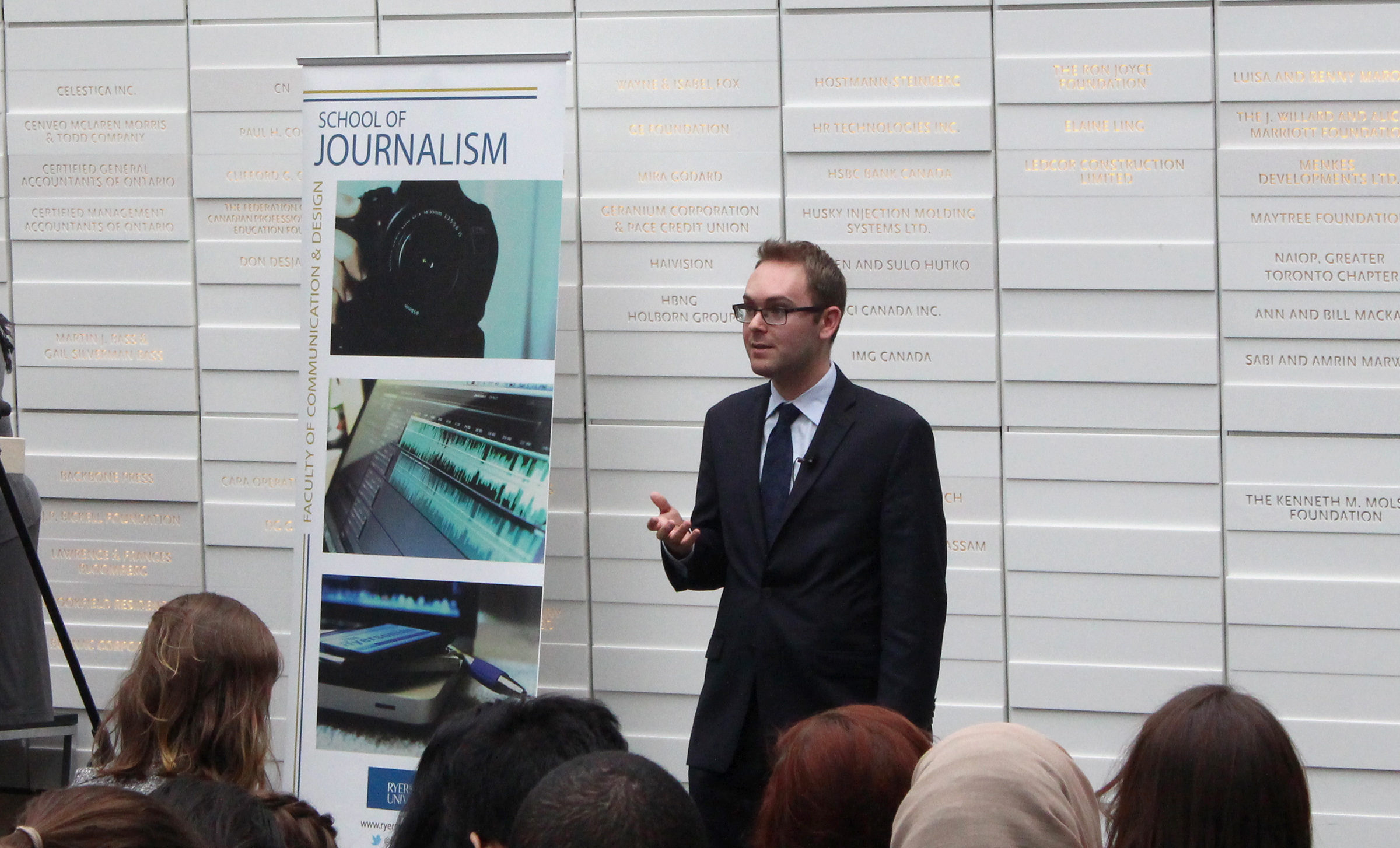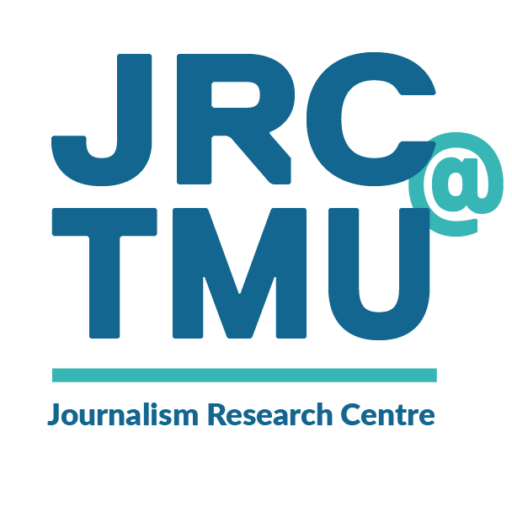By MICHAEL OTT
Special to the RJRC

The loss of trust between the media and audiences that has characterised the Donald Trump era in the United States also played out when Rob Ford was mayor of Toronto, says the Toronto Star’s Washington correspondent Daniel Dale.
Just as many Trump supporters dismiss stories about the former real estate magnate’s lies, sexism and other potentially career-destroying behaviours, many Torontonians refused to believe the worst about their former mayor, said Dale, who covered the Ford years
Dale spoke at Ryerson University earlier in February about similarities he found in covering both former Toronto mayor Rob Ford and current US President Donald Trump for the Toronto Star and what Canadian journalists can learn from how the U.S. media covered their 2016 election.
“Here we are, the Toronto Star, biggest newspaper in the city. We reported on the mayor smoking crack,” he said during a Feb. 15 presentation organized by the Ryerson Journalism Research Centre. The newspaper had a long-standing relationship with its audience before the journalists involved saw a video of the mayor smoking crack, reported on its contents and made it clear to readers how they came to view it..
Many readers, however, were skeptical: “There was a lot of doubt that what we were saying was true,” Dale told the crowd of mostly journalism students. “There was a poll done—50 per cent of Toronto residents did not believe they were telling the truth about the crack video.
Dale has since gained acclaim in the tough American media market for his coverage of Trump’s path to the White House. “Trump Checks,” his daily fact checking series, earned him a place on Politico’s list of “Breakout Media Stars of 2016” with the moniker “the lie-tracker.” Dale was also invited to discuss his Trump fact-checking coverage on CNN. Documentary filmmaker Michael Moore even tweeted his support for the Canadian journalist.
But Dale’s reporting on Trump has drawn the ire of those who refuse to believe news that reflects badly on the man who is now president of the United States.
“My email inbox is a dark place,” Dale told the audience of mainly journalism students before reading this email: “’I’m going to cancel my subscription to the Star after 20 years. Don’t believe everything you read about Trump online!’”
Dale also read a tweet from another reader: “’President Trump is going to make America great again, you may want to check out infowars.com,’” referencing a conspiracy theory-filled site that openly advocates for Trump while posting false or unsupported claims.
“We in the media have problems,” said Dale. “We have a real issue with trust.”
A recent Edelman poll suggests that trust in Canadian media is on the decline. Between 2012 and 2017, the number of survey respondents who indicated they trusted “traditional media” as a source for general news and information decreased by 13 percentage points, to 58 per cent from 71 per cent. Furthermore, respondents were 3.5 times more likely to “ignore information that supports a position they do not believe in.” This echo-chamber effect can have implications for election outcomes because it means voters are inclined to only read and trust media that reinforces their pre-judgments and beliefs.
Dale said the media coverage of Trump holds some lessons for Canadian journalists. Reporting on the U.S. election campaign, he said, suffered from:
- A sacrifice of the truth in favour of ratings.
The lack of fact-checking by many news organizations meant the pursuit of truth was sacrificed on the alter of what was trending, Dale argued.
- Problems associated with covering candidates who know how to generate headlines.
“There is a problem with allowing one candidate to crowd out everyone else,” Dale noted.
“CNN essentially became Trump News,” he said. In addition to covering every tweet and everything Trump said in the run-up to the election, the network “handed over entire hours to broadcast his rallies unfiltered.”
Dale went on to warn that something similar has happened with coverage of Kellie Leitch, who is currently running for leadership of Canada’s Conservative Party. She has, he said, made a “deliberate but skillful attempt” to crowd out her rivals and seize attention through the media.
Journalists must guard against letting one candidate dominate the coverage and instead provide equal coverage to all the leading contenders, Dale suggested.
- Fact-checking structures that focus on the average candidate.
Until Trump arrived on the political scene, fact checking by reporters involved “candidates who may tell a couple lies a week, maybe exaggerate one thing a day,” Dale said.
“These structures are not set up to deal with an avalanche of deceit,” he observed, yet reporters would fact check Trump and then report and write on him like he was an average candidate who indulged in a few minor mistruths.
In his Trump Checks series, Dale would post daily and tweet about Trump’s falsehoods. The number of lies would stretch into 10, 20, sometimes even 30 per day. Dale recently published an article showcasing the fact that Trump has told more than 80 blatant lies since taking office only one month ago.
He noted, however, that there have been improvements in the way fact checking is done. It now often happens in real time, with journalists tweeting instantly whenever Trump lies. Many broadcast news networks like CNN also began publishing live fact checking results at the bottom of the screen while candidates were speaking.
- Inaccurate reporting on what polls really mean.
Dale said that many media outlets suffered from a forecasting problem that led them to believe Hillary Clinton was destined to become the next president. At the root of it was ignorance – or a willingness to ignore – how polls really work.
“Hillary was three to five points ahead,” Dale said, but the media “was not making clear to people that she was within a pretty standard polling error.”
He said there was also insufficient coverage of the fact that national polls did not demonstrate how Clinton would perform in the key battleground states that she eventually lost to Trump. Journalists can avoid this, he said, by becoming more knowledgeable about how polls really work and avoiding over-reliance on them to tell the story.
Dale also offered advice to young journalists covering a political beat. Best practices, he said, require reporters to:
- Call out politicians when they lie. If fact checking suffers, then journalists aren’t doing their job of holding people in power accountable and they can get away with misleading the public.
- Pay attention to the other side, and not just the fringe extremist publications such as Breitbart and infowars.com. It’s important to learn about more moderate, rational viewpoints that differ from your own because it is impossible to report accurately on what is going on if you exist in an echo chamber.
- Recognize that documentation and evidence are paramount. People need solid proof before they will believe what a journalist is reporting. The Star, Dale said, learned this from the Ford crack video story. Journalists have to provide photos and video footage to back up their stories: “People want proof. They didn’t believe us when we said we saw the video ourselves.”
- Be as publicly human as possible by making clear how you go about your job and why you do what you do. Part of trust-building, he said, involves demonstrating that journalists are human and relatable people who are doing the best job they can.
- Avoid prognostication. Dale said it’s easy to slip from analysis into opinion, and that further entrenches distrust of the media among people who want verified facts and transparency about how the reporting was done and how the information was obtained.
- Become versed in policy issues. Deep knowledge will help reporters produce analysis and investigations that are essential to a well-functioning democracy.
Dale said that despite the shortcomings in the Trump coverage, a lot of important and great reporting was done over the past year.
He cited the impressive number of stories journalists uncovered about Trump by the end of the election campaign, pointing to everything from the leaked video where the candidate bragged about sexual assault, to the scandals surrounding alleged ties to Russia.
“This election was a triumph for investigative reporting,” Dale said, noting that there is “such a demand from people for investigative reporting, for smart commentary, for policy analysis.
“This is a wonderful time for journalists to do journalism.”
Watch Daniel Dale’s full lecture below:
